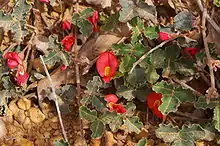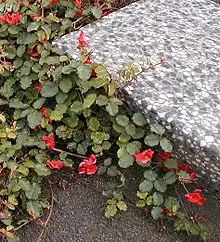Kennedia
Kennedia is a genus of plants comprising 16 species, all native to Australia. They are evergreen climbing plants with woody stems. They usually have trifoliate leaves and pea-type flowers of various colours from pink to dark red and yellow to black. The genus was named by Étienne Pierre Ventenat after John Kennedy, a partner in the renowned firm of nurserymen, Lee and Kennedy of Hammersmith, London.
| Kennedia | |
|---|---|
 | |
| Kennedia prostrata Drummond Nature Reserve | |
| Scientific classification | |
| Kingdom: | |
| (unranked): | |
| (unranked): | |
| (unranked): | |
| Order: | |
| Family: | |
| Subfamily: | |
| Tribe: | |
| Subtribe: | Kennediinae |
| Genus: | Kennedia Vent. |
| Species | |
|
See text. | |
| Synonyms | |
| |

Classification
The genus name is sometimes spelled Kennedya, but Kennedia is correct.[1]
Species
This genus has 15 recognised species and one provisional species.
Recognised
- Kennedia beckxiana — (Cape Arid kennedia). One of several Western Australia endemics. It flowers between September and December, producing red flowers with green centres.
- Kennedia carinata — Endemic to southwestern Western Australia, this species produces red to purple flowers with yellow centres between September and November.
- Kennedia coccinea — (coral vine). A species endemic to southwestern Western Australia. It spreads to over 3 meters and flowers from September to November. The flowers are yellow-centred with pale red petals edged with magenta.
- Kennedia exaltata — Queensland.
- Kennedia eximia
- Kennedia glabrata — (Northcliffe kennedia). Another species endemic to southwestern Western Australia. It flowers between August and November and has red flowers. It is listed as vulnerable under Australia's EPBC Act.
- Kennedia lateritia
- Kennedia microphylla
- Kennedia nigricans — (black coral pea). This robust Western Australian species spreads over 18 square metres (200 square feet) and is used to cover fences and sheds. The black and yellow flowers bloom from October to January.
- Kennedia procurrens — (purple running pea). A species of Queensland and New South Wales that grows on sandy soils. It produces purple flowers from the late southern winter into summer.
- Kennedia prorepens — Found in Western Australia and the Northern Territory, it produces purple, violet and blue flowers between April and November.
- Kennedia prostrata — (running postman). A widespread species found in the Australian Capital Territory, New South Wales, South Australia, Victoria and Tasmania. It flowers sparsely in red and yellow blooms. The leaves have distinctive wavy edges.
- Kennedia retrorsa — A species limited to the Mount Dangar area and the adjacent Goulburn River catchment in New South Wales. It flowers from September to December producing pink, purple, or scarlet flowers. It is listed as vulnerable under the EPBC Act.
- Kennedia rubicunda — (dusky coral pea). A widespread species from Queensland, New South Wales and Victoria. It produces pink flowers from late winter into spring.
- Kennedia stirlingii — (bushy kennedia). A Western Australian species with orange to red flowers between August and November.
Provisional
- Kennedia macrophylla — found in Western Australia, this species flowers best in shaded area with yellow and pink flowers.
Cultivation
Kennedias are frost-tolerant with a preference for light, well-drained soil in full sun. Once established they will spread into shaded areas. Western Australian species are heat-tolerant and make good covers for sheds, fences and walls with support. Many kennedias are vigorous climbers; K. rubicunda (commonly used in revegetation projects around Sydney, where it is indigenous) and K. nigricans can cover up to five metres of wall from tube in nine months. The most popular species in cultivation, K. prostrata, is a much less vigorous groundcover plant.
They are propagated from seed during spring; in the warmer summer months they are easily propagated from cuttings. This robust genus can be heavily cut back after flowering to prevent invasive growth.
References
- Kennedya DC. Australian Plant Name Index.
Further reading
- Bryant, G. The Random House Encyclopedia of Australian Native Plants: Choosing, Cultivating and Using Them. Random House. 2005. pg. 246-47. ISBN 1-74166-030-0
| Wikimedia Commons has media related to Kennedia rubicunda. |
